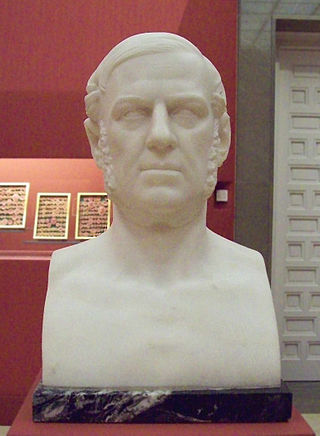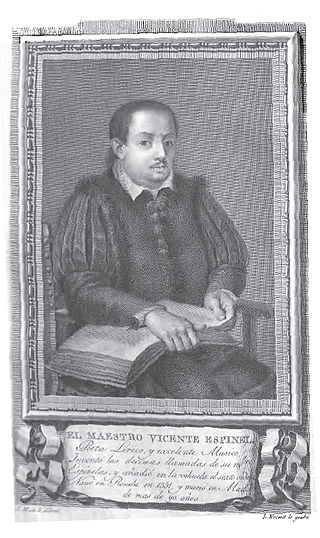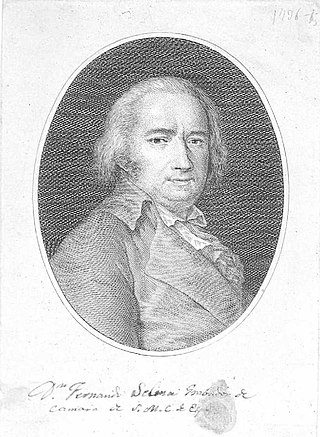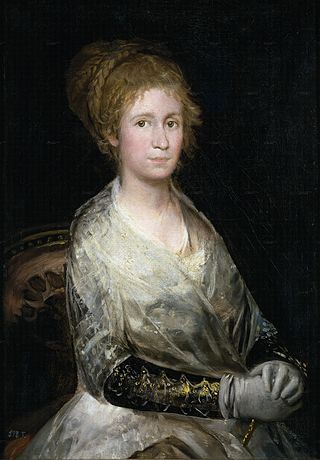Paintings at the Museo Nacional de Arte, Mexico City
- Portrait of Gerónimo Antonio Gil
- The Miracle of the Little Spring, 1809
- Portrait of Manuel Tolsá
- Portrait of Andrés Manuel del Río (1825)
- Portrait of Alexander Von Humboldt
Rafael Ximeno y Planes | |
|---|---|
| Born | 1759/60 |
| Died | 1825 |
| Education | Real Academia de Bellas Artes de San Fernando |
| Occupation | painter |
Rafael Ximeno y Planes (1759/1760–1825) [1] was a Spanish painter and draughtsman.
He was the son of a silversmith and first learned the painter's profession from his maternal uncle Luis Planes. Later he studied at the Real Academia de San Fernando in Madrid thanks to a scholarship. He also studied in Rome in 1783. In 1786 he was appointed vice-director (teniente director) of the Real Academia de San Carlos of Valencia, [2] and in 1793 he moved to Mexico City as the vice-director of the School of Fine Arts. [3]
In addition to academic canvases, Ximeno also created the frescos in the churches of Jesús María and La Profesa, in Mexico City. His fresco ‘The Assumption of the Virgin’ can be found in the dome of Catedral Metropolitana de Ciudad de México. [2] Some of his work also appears in the Basílica de la Asunción, in the town of Cieza, Spain.
Throughout his career, he made drawings which were preparatory for prints. [2] Notable among these are his illustrations for the very popular first Spanish translation of Robinson Crusoe , by Tomás de Iriarte (1750–91), published in Madrid in 1789 [4] (which is in fact a translation not of Daniel Defoe's original text, but of Joachim Heinrich Campe’s adaptation, published in Hamburg 1779–80 [5] ). Four of these preparatory drawings by Rafael Ximeno y Planes are preserved in the British Library. There are also drawings by José Juan Camarón y Meliá (1760–1819) for this edition of Robinson Crusoe in the British Library. [6]
More prints after drawings by Ximeno y Planes appear as illustrations in two editions of Don Quixote , one published by the Real Academia de la Lengua in Madrid (now Real Academia Española) and printed by Ibarra in 1780, and another published by Gabriel de Sancha between 1797 and 1798. [7] In 1779 he illustrated an edition of Crónica de Juan II by Hernando del Pulgar. [8]
The artist is also known for the engraved portraits of Charles IV of Spain, Francisco de Quevedo and Pedro Calderón de la Barca, appearing in the series Retratos de Españoles Ilustres, [9] engraved by Mariano Brandi, for which he drew the designs.

The Museo del Prado, officially known as Museo Nacional del Prado, is the main Spanish national art museum, located in central Madrid. It houses collections of European art, dating from the 12th century to the early 20th century, based on the former Spanish royal collection, and the single best collection of Spanish art. Founded as a museum of paintings and sculpture in 1819, it also contains important collections of other types of works. The numerous works by Francisco Goya, the single most extensively represented artist, as well as by Hieronymus Bosch, El Greco, Peter Paul Rubens, Titian, and Diego Velázquez, are some of the highlights of the collection. Velázquez and his keen eye and sensibility were also responsible for bringing much of the museum's fine collection of Italian masters to Spain, now one of the largest outside of Italy.

Maria del Rosario Weiss Zorrilla was a Spanish painter and engraver best known for portraits. She was the goddaughter of Francisco de Goya and lived with him during his final years when her mother was his maid. Over seventy of her drawings, preserved at the Hispanic Society of America, were once attributed to Goya but, in 1956, the art historian José López-Rey demonstrated conclusively that they were hers.

Rafael Tegeo Díaz was a Spanish Neoclassical painter, known primarily for his portraits. His name is sometimes spelled Tejeo.

Friar Juan Bautista Maíno, or Mayno was a Spanish Baroque painter.

José Camarón Bonanat, or Bononat was a Spanish draftsman, painter and engraver. Most early sources give his maternal family name as Boronat.

Bernardo López Piquer was a Spanish portrait painter; noted especially for his pastels.

Antonio Gisbert Pérez was a Spanish artist situated on the cusp between the realist and romantic movements in art. He was known for painting pictures of important events in a country's history in a realistic style, yet clearly with a political aim as well; his variance in styles puts him in the Spanish eclectic school of painters. He generally tried to promote liberal causes in his politics and paintings.

The Nobleman with his Hand on his Chest is an oil painting by El Greco, one of the earliest works painted by the artist in Spain.

Valentín Carderera y Solano was a Spanish painter, erudite scholar and collector. He was named honorary court painter during the reign of Isabel II.

Portrait of a Nobleman is a c.1586 oil on canvas portrait by El Greco, originally hung in the Quinta del Duque del Arco in Royal Palace of El Pardo in Madrid but now in the Museo del Prado. Its subject is unknown.
Andres Rossi was a Spanish artist. He worked as a painter, draughtsman, print maker, sculptor and writer in Madrid and Seville.
Francisco Javier Sánchez Cantón (1891–1971) was a Spanish art historian, who from 1960 to 1968 was Director of the Museo del Prado.

Luis Fernández Noseret was a Spanish engraver who studied with Manuel Salvador Carmona at the Real Academia de Bellas Artes de San Fernando.

Fernando Selma was a Spanish engraver and illustrator.
Pieter Perret was a Flemish engraver who worked in Madrid in the service of Philip II of Spain.

Aureliano de Beruete y Moret was an art critic and historian; son of the painter, Aureliano de Beruete. He served as Director of the Museo del Prado from 1918 until his death.
Guillermo Ducker was a Dutch miniaturist active mainly in Madrid, Spain between 1795 and 1830. He is known to have painted for Spain's royal family as well as for Madrid's high society, until at least 1813, when he painted a miniature of Joaquina Téllez Girón, Marchioness of Santa Cruz.

Self-Portrait at 69 Years is an oil painting by the Spanish painter Francisco Goya. Two original versions of this work have been preserved. One of the paintings, painted on canvas, is housed in the collections of the Prado Museum. The other, created on wood panel, is located in the Real Academia de Bellas Artes de San Fernando in Madrid. Both paintings were created in 1815, in the post-war period, and depict a very similar image of the artist. This is one of the most sincere and direct self-portraits of the painter.

Josefa Bayeu or Leocadia Zorrilla is an oil painting by the Spanish painter Francisco Goya. It is currently housed in the Museo del Prado.
Constructs such as ibid. , loc. cit. and idem are discouraged by Wikipedia's style guide for footnotes, as they are easily broken. Please improve this article by replacing them with named references ( quick guide ), or an abbreviated title. (March 2020) |
![]() Media related to Rafael Ximeno y Planes at Wikimedia Commons
Media related to Rafael Ximeno y Planes at Wikimedia Commons